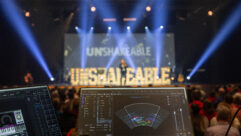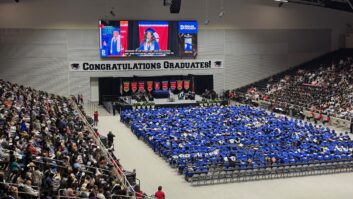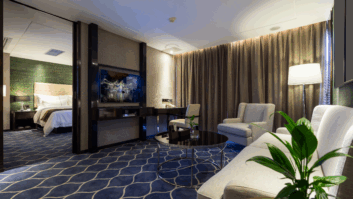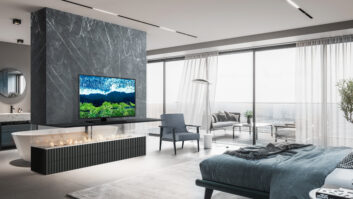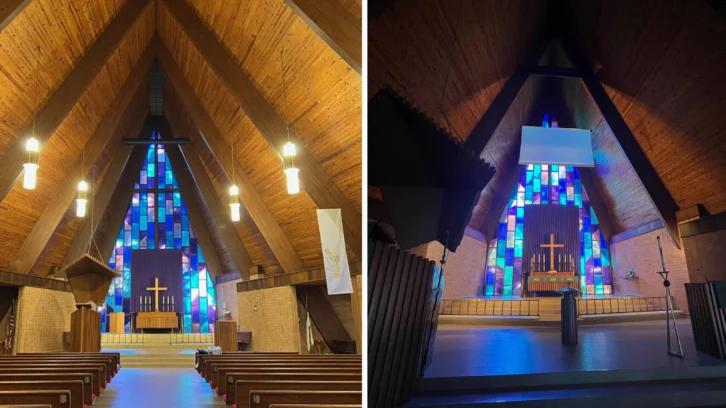
Concordia Lutheran Church in Conover, NC was born from the ashes of Concordia College. The college, which closed after a fire in 1935, was resurrected as the house of worship in 1958. For decades, the church was able to get by with a basic PA system—but when the pandemic hit, Concordia Lutheran Church knew it was time for change. Ryan Gilbert, owner of RYGID AV, and his team helped bring the church into the 21st century and readied the house of worship for years beyond with new AV solutions.
Leadership at Concordia Lutheran Church wanted to adapt to the post-pandemic years and be able to livestream and connect with remote congregants. Just one problem: There was an existing PA system with an analog soundboard that was roughly 30 years old—and that’s it.
“There was actually no video in that sanctuary at all,” explained Gilbert, who was charged with design and engineering for the project. “They didn’t want an LED wall floating in the middle of the room; they didn’t want TVs hanging from the side. So, projection was really the key thing here.”
Stained Glass and a Copper Roof
“We had looked for a solution to place video screens in our sanctuary for many years,” explained Doug Brady, lay leader at Concordia Lutheran Church. “The congregation has always been concerned with the aesthetics of the sanctuary and was reluctant to place screens in the church. I had met with several audio and video companies, and no one had a solution that we felt comfortable with. When I approached Ryan Gilbert of RYGID AV about our project at Concordia Church, I was immediately impressed with their knowledge and experience.”
The main reason the church had reservations about adding video was an eye-catching, massive stained-glass window with a large cross in the center that simply couldn’t be blocked from view. Also, the church leaders and Elders wanted to ensure none of the preexisting architecture or features were compromised, whether it was from reflections or bulky technological eyesores.
“You can’t hide that, it’s beautiful,” said Gilbert of the signature window and cross. “The architecture is amazing.”
Gilbert’s solution was projector screens from Screen Innovations. “It was a no brainer,” he said. “We have great support from the Screen Innovation team, and I’ve just been itching to put in a Zero-G screen, and I see no better option in this room for what was asked of us.”
Gilbert and his team got to work on installing cameras, projectors, screens, and a new audio system. The project began in late May 2023 and was completed three weeks later, followed by two days of training for the church staff.
Unsurprisingly, the preexisting technology (or lack thereof) wasn’t the only challenge. The 52- foot ceiling and 120-foot-long sanctuary offered their own acoustic and visual challenges.
“The building looks like a Thanksgiving cornucopia,” explained Gilbert. “It has a beautiful copper roof, wood finishes, and tile floor. But the shape of the room alone was a major challenge both in what do we do for PA and to keep it discreet. And same thing with projection: Where do we put video elements in here that can be discreet? It was a major challenge to deal with just the shape and acoustics of the room. Then you’re talking 65-year-old beams that are holding this roof structure up. That’s what we were hanging everything from.”
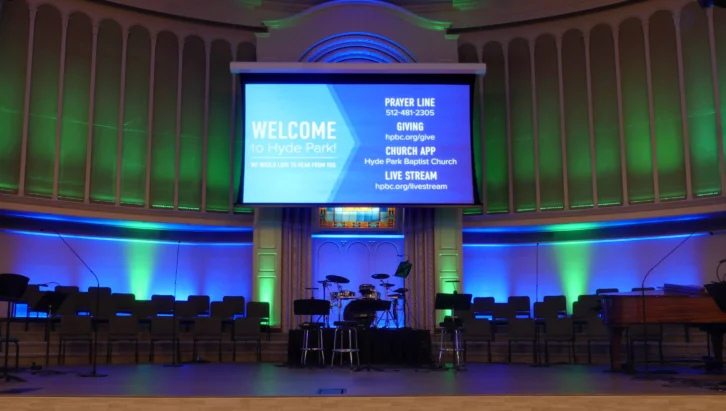 Big But Discreet
Big But Discreet
In the age of massive displays and LED technology, why did Concordia Lutheran Church want a projection system and not the latest pixel-perfect LED display? Budgetary concerns are always a factor, of course—but in this case, it went a little deeper. It was very important to have something that produced high-quality visuals but could easily go away when not in use.
RYGID AV brought video projection to life at both the front at the rear of the church by pairing a Screen Innovations Zero-G screen with a Digital Projection projector and a Screen Innovations Solo 3 screen with an Epson projector. A three-camera PTZ system was also installed, as well as an updated line array sound system. There’s also an Elgato Stream Deck for control and a new PC running ProPresenter 7.
“We used BirdDog’s 4K P400 cameras,” explained Gilbert. “It’s all Blackmagic 4K video switchers and streamer and recorder. The projector is a Digital Projection E-Vision 9100, and the rear projector is an Epson. On the audio side was a mixture of Shure and Audix microphones and an Allen and Heath SQ-5 soundboard with an Adamson IS7 and IS118 line-array system. The sound booth was very small, so we crammed a lot into a very small space. Again, discretion was key to go stereo—the PA would have been very in your face from a visual perspective. And everybody agrees that a single mono hang would be just fine. You can hardly tell that it’s even up there.”
Of course, the centerpiece was the Screen Innovations Zero-G projection screen on a motorized pulley system to disappear when not in use. “We’ve been pretty loyal to Screen Innovations for several years now,” Gilbert said. “Their fabric is amazing, and I’ve always had this dream of doing a Zero-G screen hanging on aircraft cables. I think there are only three companies that even make a screen like that.”
The trick was getting the projector and screen matched up in the massive room without exposing the technology too much. And that meant considering ambient lighting and clarity of the visuals from the right distance. “Option A was to hang the [projector] right in the middle of the room, but everybody hated that idea,” Gilbert recalled. “It was a 120-foot-long room, and I could not find a lens to throw that distance. So, I couldn’t put it at the very back of the room.”
The solution to hiding the projector was quite innovative. “We came up with this really creative idea called a docile curtain,” said Gilbert. “The docile curtain does not move; it stays there 24/7. It’s anchored in the concrete. The projector is supported by a 15-foot truss structure that is anchored to the back wall, and the projector is sitting on that. And if you’re in the balcony, you can see the top two inches of the projector peeking out above that docile curtain, so it’s hiding behind that purple curtain.”
The screen is roughly 133 inches diagonal, which itself led to some challenges. “It can only go so high,” said Gilbert. “We had to take the case into consideration. When it’s retracted, how high does it go? Mathematically speaking, the screen itself is slightly undersized for the room. But when you take in those other factors, that was the reason why we went with that.”
Changing the Service
Concordia Lutheran Church now has the system in place to move forward in live-streaming video for everything from services to educational classes. Perhaps most importantly, it was easy to learn and use, changing the way the church has done things in the past.
“The reaction from the congregation has been that they’ve completely changed the front end of their service,” said Gilbert. “First thing [the Pastor] would do was the announcements. He’s even stopped doing that because it’s on the screen before he comes out there. There’s a day school there that is now coming in during the week and using it—and the sound, everybody has done nothing but compliment the sound. People think it looks fantastic.”
“What we at Concordia Church like is how [the screen] is hidden away in a case when it is not in use,” Brady added. “The simplicity of how it is lowered into place was the perfect solution. The use of a rear projector was also a great idea. The congregation has been pleased with the results. Ryan and his team did an excellent job with the installation and training that followed. We look forward to working with them in the future.”



